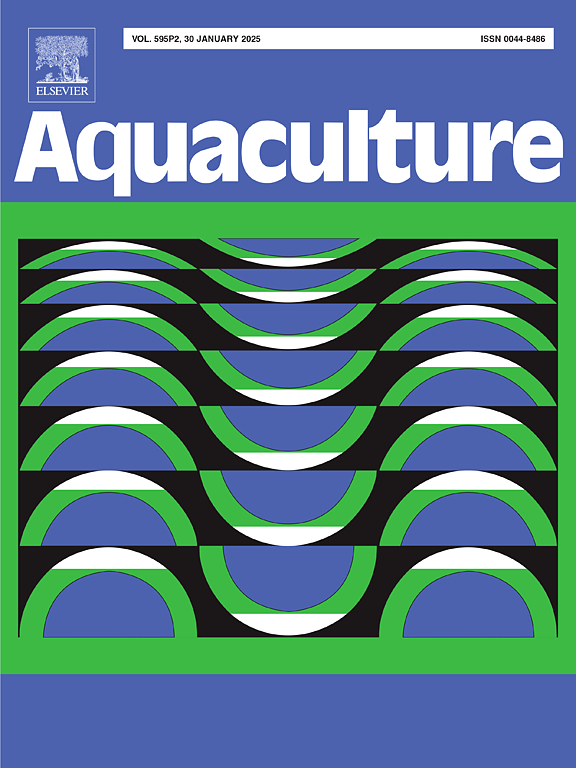Growth performance, biochemical indexes, and intestinal microbiota of Phoxinus lagowskii larvae under carbonate alkalinity stress
IF 3.9
1区 农林科学
Q1 FISHERIES
引用次数: 0
Abstract
The Amur minnow (Phoxinus lagowskii), a commercially significant cold-water fish, faces challenges in saline-alkaline aquaculture due to limited understanding of early-life stage adaptations. This study investigated the integrated adaptive mechanisms of the embryonic and larval stages in response to carbonate alkalinity stress (0–8 mmol/L carbonate alkalinity) through histological, physiological, and microbiome analyses. The results revealed that moderate alkalinity (2–6 mmol/L) did not compromise hatching success, larval survival, or growth performance. However, high alkalinity significantly reduced hatching rates, and induced hepatic oxidative stress characterized by elevated activities of SOD, CAT, ALT, and AST, and altered intestinal morphology. The gill osmoregulatory capacity was enhanced through upregulation of Na+/K+-ATPase (NKA) and Ca2+/Mg2+-ATPase (CMA) activities, along with increased expression of AQP1 and NHE3, highlighting critical ionoregulatory adjustments. Immune-related genes (TNF-α, IL-10, IL-13) in the liver were significantly upregulated. The intestinal microbiota exhibited resilience under alkalinity stress, with an increase in Proteobacteria and the probiotic Gemmobacter, alongside a reduction in the pathogenic Shewanella. This study elucidates the synergistic roles of hepatic antioxidant defense, gill osmoregulatory plasticity, and intestinal microbial dynamics in mediating alkalinity tolerance, providing actionable insights for optimizing saline-alkaline aquaculture practices.

碳酸盐碱度胁迫下拉格氏鱥幼虫生长性能、生化指标及肠道菌群
黑龙江鲦鱼(Phoxinus lagowskii)是一种具有重要商业价值的冷水鱼,由于对早期生命阶段适应的了解有限,在盐碱水产养殖中面临挑战。本研究通过组织、生理和微生物组分析,探讨了胚胎期和幼虫期对碳酸盐碱胁迫(0-8 mmol/L碳酸盐碱)的综合适应机制。结果表明,中等碱度(2-6 mmol/L)不会影响孵化成功率、幼虫存活率或生长性能。然而,高碱度显著降低了孵化率,并诱导肝脏氧化应激,其特征是SOD、CAT、ALT和AST活性升高,并改变了肠道形态。通过Na+/K+- atp酶(NKA)和Ca2+/Mg2+- atp酶(CMA)活性的上调,以及AQP1和NHE3的表达增加,鳃渗透调节能力增强,突出了关键的离子调节调节。肝脏免疫相关基因(TNF-α、IL-10、IL-13)显著上调。肠道微生物群在碱性胁迫下表现出弹性,变形菌和益生菌Gemmobacter增加,致病性Shewanella减少。本研究阐明了肝脏抗氧化防御、鳃渗透调节可塑性和肠道微生物动力学在调节碱性耐受性中的协同作用,为优化盐碱养殖实践提供可操作的见解。
本文章由计算机程序翻译,如有差异,请以英文原文为准。
求助全文
约1分钟内获得全文
求助全文
来源期刊

Aquaculture
农林科学-海洋与淡水生物学
CiteScore
8.60
自引率
17.80%
发文量
1246
审稿时长
56 days
期刊介绍:
Aquaculture is an international journal for the exploration, improvement and management of all freshwater and marine food resources. It publishes novel and innovative research of world-wide interest on farming of aquatic organisms, which includes finfish, mollusks, crustaceans and aquatic plants for human consumption. Research on ornamentals is not a focus of the Journal. Aquaculture only publishes papers with a clear relevance to improving aquaculture practices or a potential application.
 求助内容:
求助内容: 应助结果提醒方式:
应助结果提醒方式:


